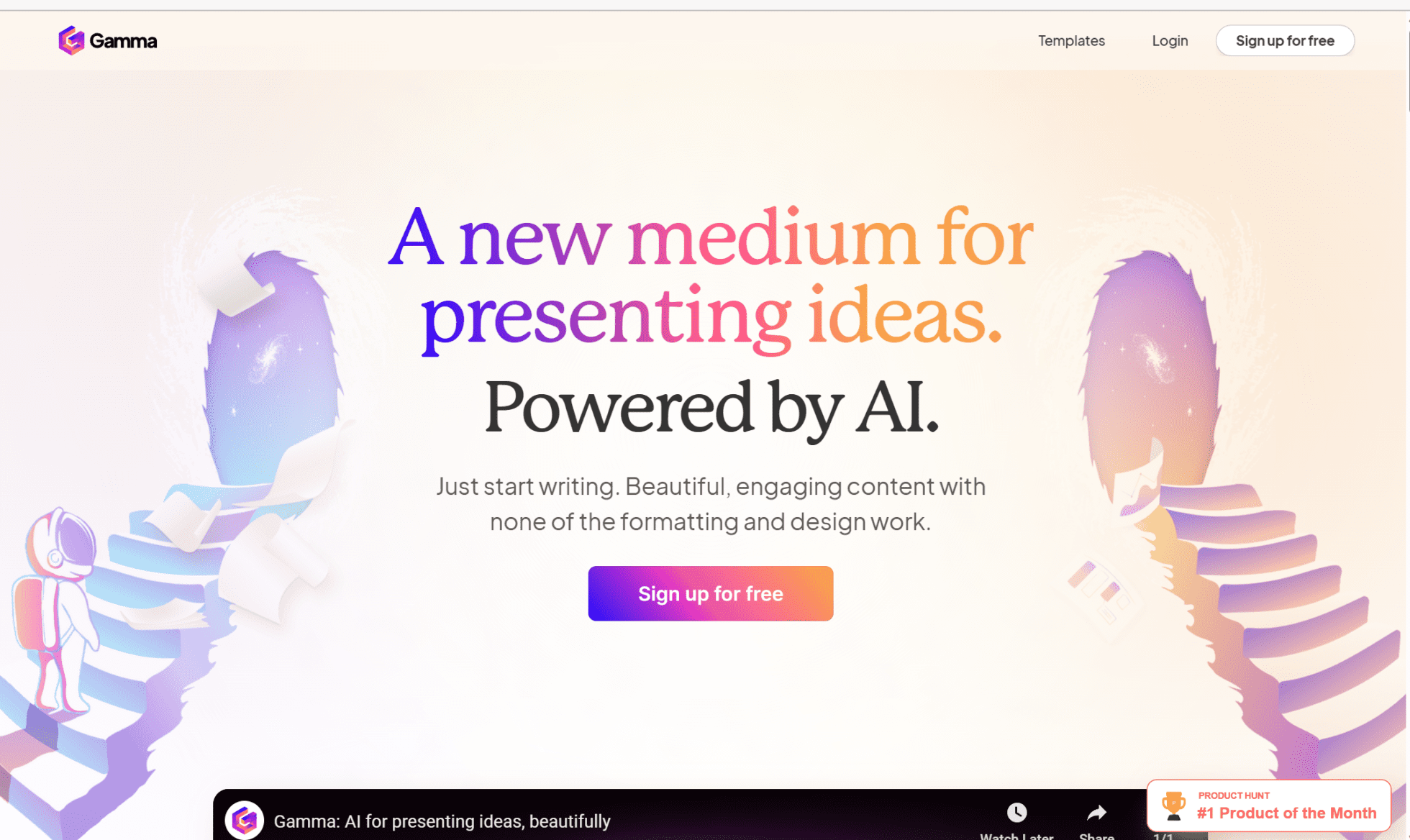Remote team collaboration tools are everywhere nowadays. Since the digital revolution, you can’t swing a virtual cat without hitting one. But are they actually any good? Nobody has the time to check out every single one, especially not when they’ve got important work to do, big ambitions to pursue, and regular meetings to attend.
@tldv.io Makes perfect sense. #meeting #comedy #corporate #meetings #9to5 #firstday
♬ original sound - tldv.io - AI Meeting Recorder
That’s why we’ve done the hard work for you. As a fully remote and async team, we’ve used a lot of collaborative tools for remote working. And because we’re feeling generous, we’ve gathered our top 5 here to save you some time.
Top 5 Tools for Remote Collaboration
1. Gamma

AI is taking the world by storm, so it’s no wonder that a lot of the best remote work collaboration tools are integrating it. With Gamma, you can generate docs, decks and webpages in seconds. You can also restyle your entire deck with just one click. Essentially, this powerhouse of a tool makes it super simple for you to create jaw-dropping presentations in a fraction of the time it usually takes.
Gamma also allows its users to measure engagement with built-in analytics. You can get feedback with quick reactions and also more in-depth comments.
With dozens of templates to choose from, getting into Gamma now is a good idea as there is currently only a free plan available! The Pro Plan is listed but they have not yet launched it to the public. This state-of-the-art software enables you to save time making dreamy presentations and it doesn’t cost you a dime.
Pros
- Stunning presentations, web pages, and other graphics automatically generated from your prompt
- Lots of templates to choose from
- Good free plan (subject to change)
- State of the art AI
Cons
- Can take a while to load the final product
- Can be buggy in non-Chrome browsers
2. Rows

While Rows ensures you’ll feel right at home with all your favorite spreadsheet shortcuts, it takes things to the next level by integrating with AI to create one of the best tools for remote collaboration the spreadsheet space has ever seen. With eye-catching reports that fit elegantly into the spreadsheet, you can tell better stories with data.
Rows doesn’t require you to be a spreadsheet wizard either. In fact, spreadsheets have been re-imagined for simplicity so that anyone can open Rows and use it like they’re a pro. You can also include interactive buttons, input fields and date pickers to make your data POP.
With dozens of integrations, you can easily program your spreadsheet to provide you with the most recent data, taken directly from the external source itself. For example, you can link your spreadsheet to Google Analytics, empowering you to get the data you need when you need it. It will update automatically and you can set the frequency, from every minute to every month.
You can collaborate in real time, a feature that is essential for remote team collaboration tools. It’s also integrated with GPT-3 so you can get help from your AI co-pilot from inside your spreadsheet.
Pros
- Collaborate in real time
- Dozens of powerful integrations so you can keep your data up to date
- GPT powered AI co-pilot
- Super easy-to-use
- Designed to elegantly display data
- Ready-to-go templates available
- Great free plan
Cons
- To get the 1 minute automation frequency, you’ll have to fork out $59 per month
- Could have more tutorials for beginners
3. Discord

Originally a messaging app for gamers, Discord has branched out into the ideal hub for communities, whether they be for gamers, crypto projects, or even businesses. That’s right, Discord is now a valid alternative to Slack for all things work-related.
The ability to create different invite-only channels for different aspects of work is something that is essential for remote teams. It’s a great place for organization. There’s also a voice chat option in which your friends or colleagues can see that you’re available and hop onto voice chat to say “Hello.” This is something that can be quite beneficial for remote teams who rarely see each other face to face.
If you’re part of a remote team, Discord is the best place to be communicating. It’s easy to set up, easy to use, and easy to stay organized.
Pros
- Create different channels to separate work chats into specific niches
- Invite-only channels available
- Voice chat option is great for remote workers
- Easy to set up and use
- Affordable plans
- Lots of integrations with third party apps
Cons
- Interface can take a while to get used to
- You must pay for higher-quality video and audio calls
4. tl;dv
tl;dv is the king of remote team collaboration tools. Why? Imagine an online meeting recorder that allows you to transcribe the entire text of the call, accurately identifying the speakers and labeling them accordingly.
Imagine that this tool recorded video too. Imagine you can create clips, reels, and highlights – now imagine that AI could do it for you if you were in a hurry, editing your clip so that you highlight the most important parts while making it easier for your colleagues to watch.
Imagine this tool could translate the transcript in over 25 languages. And imagine that it’s available instantly as soon as the call ends. Imagine you can get AI summaries of the call generated automatically, or AI notes taken throughout.
Imagine you could tag colleagues at important parts so that they get a timestamp straight to their email which takes them directly to the part they need to see. Imagine that, using the tool’s many powerful integrations, you could share your videos or edited highlights in a simple click. Now, this next one takes a lot of imagination. Imagine it’s all free.
You’re imagining tl;dv.
Pros
- Free AI integration for summaries, notes, and automatic speaker detection
- Live transcriptions in 25+ languages for Zoom and Google Meet
- Free and instant transcript translations
- Unlimited free recordings of Zoom and Google Meet calls
- Easy-to-use and intuitive
- Time-stamped highlights and the ability to tag colleagues at specific meeting moments
- Push timestamps and meeting clips directly to Notion, Slack, HubSpot, and Salesforce via integrations
- Highlight transcript to create clips out of recorded meetings
- Search your meetings library for keywords in transcripts
Cons
- Not available for Microsoft Teams (Yet!)
5. Trello

Saving the big daddy til last, Trello is one of the best collaborative tools for remote working. If you’ve ever worked remotely, chances are you’ve used Trello at some point. It’s a workflow and task management software that enables you to organize your work tasks with ease.
With handy color coding, different boards and cards, you can easily organize and streamline your work process with Trello. Assign workmates to specific cards and set deadlines. When they’re finished, they can mark it as complete and move it to another column for proofing.
It’s one of the best tools for remote collaboration and it’s almost guaranteed to boost productivity.
Pros
- Generous free plan
- Excellent mobile app and desktop version
- Clean and simple user interface
- Tons of integrations
Cons
- Limited analytics and reporting
The Verdict
There are thousands of collaborative tools for remote teams out there. In our opinion, these 5 are the crème de la crème.
For project management and organization of remote teams, Trello is the top dog.
For all things online meeting related, of which there will be a lot in remote teams, tl;dv is a godsend.
For communication, Discord is Slack’s biggest rival, and we think it just pips it.
For spreadsheets and data tracking, look no further than Rows, an AI-powered spreadsheet service that puts Excel and Google Sheets to shame.
For AI presentations, pitch decks, documentation and webpages, Gamma is an excellent tool to try out.
These 5 tools can be used together by one organization. None of the tools compete with each other, and all of them have free plans for you to try before you buy. tl;dv’s free plan in particular is enough to cause your mouth to start watering.





